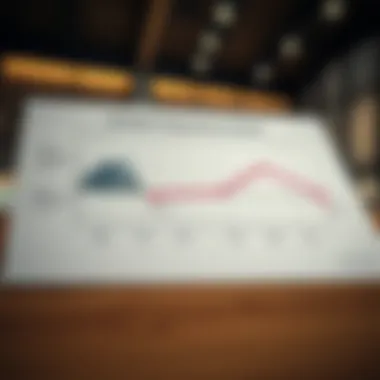Conversion of Feet to AED: A Guide for Investors


Intro
In the vibrant and ever-evolving landscape of Dubai's real estate market, understanding the interplay between measurement units and currency valuation is crucial for investors. As property transactions often hinge upon precise measurements and conversions, this article delves into how feet convert to AED, and the broader implications of these conversions for investment strategies. Whether you are a seasoned investor or a first-time buyer, grasping these details could significantly influence your decision-making process.
Real estate in Dubai is not merely about brick and mortar; it also involves navigating a maze of numbers and valuations. Having a solid understanding of how space is measured and priced lays the groundwork for successful property investment. With prices fluctuating and markets shifting, even the tiniest detail—like a foot here or an AED there—can make all the difference. Here, we aim to equip you with insights and knowledge, so let's embark on this exploration together.
Prelims to Measurement Conversions in Real Estate
In the complex world of real estate, the importance of measurement conversions cannot be overstated. For property investors, particularly in a booming market like Dubai, understanding the conversion of physical measurements into monetary terms is a crucial skill. As this article unfolds, we'll delve into the various facets of measurement conversions, grasping their significance for pricing, investment balance sheets, and overall market appreciation.
One might wonder, why is accuracy in measurements worth the fuss? Well, imagine a scenario where an investor inaccurately calculates the area of a property based on flawed feet-to-AED conversion. This could lead to drastic mispricing, potentially costing a fortune. Correct measurements ensure that both buyers and sellers are on equal footing, making transactions smooth and minimizing disputes. Investors can confidently navigate contract values, making smarter financial decisions as a result.
Additionally, modern real estate relies heavily on precise specifications. The conversion from feet, a physical dimension, to AED, a currency format, shapes financial projections and operational plans. When investors grasp how to interpret and apply these conversions, they can develop strategic pricing models, incorporate realistic budget forecasts, and analyze market trends with accuracy—all essential for thriving in fast-paced property landscapes.
For property enthusiasts and investors alike, this understanding also fosters a sense of confidence in negotiations. With a firm grip on the metrics that matter, the chances of achieving favorable terms and deals substantially increases. The interplay between measurement and currency is not merely academic; it's a keen edge in maximizing investment potential.
With that said, let's transition into the necessity of accuracy in the measurements utilized within this context.
Importance of Accurate Measurements
Accuracy in measurement is the bedrock of sound real estate transactions. It not only affects pricing but also influences market analysis and valuation. An error in converting feet to AED can lead to significant discrepancies, impacting everything from property listings to investment assessments. Consider this: if a home is listed without precise square footage, it may attract either a slew of uninterested buyers or generate offers that fall woefully short of the property's worth.
Rounding up or down can result in inflated expectations or misjudged valuations. For investors, this lack of diligence often translates into losses, whether it be through overpaying for a property or underestimating potential rental yields. Accurate measurements serve as a foundation for creating comparative analyses, essential for understanding value per square foot against the current market rate in AED.
Moreover, financial institutions might require precise figures when assessing property for loans or mortgages. This emphasizes the need for reliable data. Investors should prioritize accurate, up-to-date measurements in their analyses and calculations to bolster their investment savvy and decision-making processes.
Understanding Currency in Real Estate
The relationship between feet and AED cannot be comprehended without a solid grasp of the economic principles at play. Property investors need to contextualize their investment within the landscape of the local currency—the United Arab Emirates Dirham (AED). The currency's stability, inflation factors, and trading conditions directly affect how property is valued in financial terms.
To illustrate the dynamic nature of these factors, look at inflation rates. When the AED experiences inflation, the purchasing power diminishes. This may require investors to account for this fluctuation in their property valuations over time. Furthermore, trade balances can shift unexpectedly; when there’s a trade deficit, the dirham could weaken, altering property values predicted through simple conversions from feet to AED.
Defining Feet in Real Estate Context
Understanding measurements is crucial in the realm of real estate, especially in markets such as Dubai where property investments are highly competitive. The measurement unit of feet, while commonplace in many regions, carries particular significance in the property sector. It serves not just as a unit of space but as an essential tool for buyers, sellers, and investors to gauge property dimensions and ultimately, value.
In real estate, the use of feet often intertwines with other essential factors, such as property pricing and market trends. Knowing how to convert these measurements into a currency context, specifically the AED, equips investors with a clear edge when evaluating potential investments. The conversion of feet into AED reflects not just the raw data of a property’s size but also plays a vital role in strategizing purchase decisions and understanding the dynamics of land valuation.
Why Feet is a Common Unit
Feet is a widely recognized unit of measurement in real estate, particularly in countries influenced by British or American systems. This familiarity breeds consistency in property listings, making it easier for buyers and investors to compare different options across the market. When assessing properties in Dubai, where space can be at a premium, understanding dimensions in feet helps stakeholders visualize layouts and functional spaces more effectively.
Moreover, feet as an indicator plays a substantial role in determining the overall value of a property. For instance, when comparing two properties with the same square footage, nuances in layout or amenities can mean the difference between a good investment and a financial mistake. This highlights the importance of feet as not merely a measurement but as a language of its own in the real estate world.
Comparative Units in Global Real Estate
When examining properties across different countries, understanding that feet isn’t the only measurement in town is essential. Markets like Europe often rely on metrics such as square meters. Each measurement unit has its own nuances and implications, which can bewilder those unfamiliar with international standards. For a property investor in Dubai, in-depth knowledge of these units becomes vital.
Common comparatives include:
- Square Meters: Predominantly used in Europe and parts of Asia.
- Acres: Common in rural areas, particularly in the United States.
- Square Yards: Frequently used in the UK and India.


Investors should know how to convert these measurements, as they can drastically alter property valuations. For example, converting square meters to square feet can give a clearer picture of space when evaluating properties in Dubai compared to Western markets. Understanding these differences is key to making informed decisions and enables savvy investors to anticipate potential market shifts just by considering measurement conversions.
Currency Overview: AED
The United Arab Emirates Dirham, often abbreviated as AED, plays a crucial role in the asset class of real estate investing in Dubai—especially when it comes to understanding property valuation in terms of conversions from feet to AED. Knowing the intricacies of AED is fundamental for any investor looking to navigate the vibrant Dubai market.
Preface to the United Arab Emirates Dirham
The Dirham, established in 1973, is the official currency of the UAE. It's not just a unit of exchange; it represents a stable monument to the region's economic progress. For investors, familiarity with AED enhances one's ability to gauge buying power and inform property investment strategies.
The symbol for the Dirham is "د.إ," and its value is pegged to the US dollar, which stabilizes it amidst fluctuations in the global economy. This pegging is appealing for property investors since it provides a clear baseline when considering property valuations. Understanding the Dirham is thus not merely an academic exercise; it’s foundational to making sound investment decisions.
Economic Factors Influencing AED Value
Several pivotal economic factors have a say in the value of the AED. Addressing these can provide insights as to why real estate price patterns behave the way they do.
Inflation Rates
Inflation can be a double-edged sword when it comes to the AED. With inflation rates remaining relatively controlled in the UAE, investments generally hold their value. Investors prefer to operate in a stable environment with limited inflation, particularly in sectors like real estate where long-term investments are common. If inflation spikes, it can erode purchasing power, making property less attainable.
One unique feature of controlled inflation is that it allows for predictable returns on investment. However, pressures from external markets can sometimes induce inflation, leading to price increases in materials and construction costs, which ultimately influences property prices.
Trade Balances
Another vital cog in the machinery of AED value is the trade balance. The UAE has a trade surplus, meaning it exports more than it imports. This surplus strengthens the Dirham. When foreign currencies flow into the UAE for commodities like oil or tourism, it pushes demand for the Dirham up.
What makes the trade balance particularly interesting is how it interacts with global trade conditions. A slowdown in trading partnerships could negatively affect the surplus and, subsequently, the AED. Thus, investors need to stay tuned to global economic news and align their investment strategies accordingly.
Monetary Policy
Monetary policy reflects the government's approach to managing the money supply and interest rates. For AED investors, this policy can significantly affect property values. The UAE central bank employs policies designed to safeguard the currency's value, making the Dirham a reliable vehicle for investment.
A lower interest rate environment often spurs borrowing, which can lead to a surge in real estate investments. However, if interest rates rise, it could result in the opposite effect, cooling the market. Investors should pay attention to announcements from the UAE central bank about interest rate changes, as these can have rippling effects on property prices.
Understanding these economic factors can provide investors with a solid foundation for making well-informed property investment decisions. Keep a close eye on these elements, and it may just give you an edge in the competitive real estate landscape of Dubai.
"Knowledge of the currency and its economic factors equips you to make sound investment choices. The devil is always in the details, especially in the world of property."
For more detailed perspectives on currency, trade, and monetary policy, refer to Wikipedia or Britannica.
Conversion Rates of Feet to AED
When investing in property, particularly in a dynamic market like Dubai, understanding conversion rates is not just a matter of mathematical convenience; it’s crucial for making informed financial decisions. The conversion of feet to AED touches upon everything from property valuation to rental pricing, playing a pivotal role in investor strategies. Whether you’re a seasoned property investor or a newcomer exploring options, grasping the nuances of these conversions can significantly influence your investment approach.
Understanding conversion rates allows investors to accurately assess property value in relation to its size, which is typically measured in square feet. This relationship is essential since it directly impacts how much you're willing to pay and how you perceive a property’s worth. Knowing how to convert square feet into AED helps in comparing different properties and understanding their pricing relative to the market.
Current Conversion Rate Analysis
In the real estate landscape, current conversion rates from feet to AED provide a snapshot of market conditions. As of lately, the average price for residential property in Dubai hovers around AED 1,500 per square foot in popular areas like Downtown Dubai or Dubai Marina. However, this can fluctuate depending on property type and location. For instance, luxury developments often command higher prices, sometimes reaching figures like AED 2,500 or even more per square foot.
Factors influencing current rates include:
- Location: Prime areas command premium prices.
- Property Type: Apartments, villas, and commercial spaces vary distinctly in pricing.
- Market Demand: Economic shifts and buyer sentiment can impact prices significantly.


Here’s a simple table to put it into perspective:
| Location | Price per Square Foot (AED) | | Downtown Dubai | 2,000 | | Dubai Marina | 1,800 | | Jumeirah Village Circle | 1,200 | | Silicon Oasis | 800 |
Staying updated with these rates is imperative. Investors can subscribe to real estate platforms for real-time data or consult with local experts to gauge the fluctuations.
Historical Trends in Conversion Rates
Analyzing historical trends in conversion rates provides insights into the direction of the market. Historically, there has been a consistent rise in property values in Dubai, particularly in the aftermath of major global events such as the Expo 2020, which positively affected the local economy and spurred property investment.
Noteworthy points in the historical context include:
- 2015-2016 Contraction: Following a peak, property prices dropped due to various global economic pressures, creating a buying opportunity for savvy investors.
- 2018 Recovery: Prices began to stabilize again, reflecting renewed interest from both local and international buyers.
While the last few years highlighted fluctuations, the long-term trajectory seems to favor steady appreciation. Investors who kept an eye on these trends in the past have often found advantageous entry points into the market.
"Real estate is not just about the property itself, but understanding the economic pulse that drives its value."
Historical data is typically collected from resources such as the Dubai Land Department, as well as various property price index publications that track such fluctuations.
Practical Applications in Real Estate Investments
Understanding the conversion of feet to AED is not just about numbers; it’s about making savvy investments in a complex real estate landscape. This section brings clarity to property investors, enabling them to navigate costs, valuations, and market strategies with greater confidence. By zeroing in on practical applications, one can comprehend how these conversions play a pivotal role in shaping investment decisions.
Calculating Property Costs Using Feet and AED
When assessing property costs, a thorough understanding of how feet translate into AED can save investors from costly mistakes. Using the square footage of a property allows one to establish a baseline for what they might expect to pay. For example, if an apartment boasts 1,500 square feet and the current market rate is 1,000 AED per square foot, the total price of the property is a straightforward calculation: 1,500 multiplied by 1,000, which equals 1,500,000 AED.
In contrast, investors often overlook additional costs such as fees related to maintenance and property management that can vary widely based on size. These initial calculations offer a glimpse of total investment but must be bolstered with considerations, such as market demand and future valuation.
Valuation Techniques Based on Measurements
Valuation techniques that are rooted in solid measurement practices serve as cornerstones for investment analyses. Understanding these avenues can inform a better strategy for making offers or negotiations.
Cost Per Square Foot Analysis
One prominent aspect of valuation is the Cost Per Square Foot Analysis. This technique hinges on measuring the space of a property and then comparing it to similar properties in the area to determine a fair price. It’s particularly effective in real estate markets like Dubai where variations in property sizes can be significant.
A definitive characteristic of this analysis is its straightforwardness—it's easy to grasp and apply, making it a go-to method among seasoned investors and newcomers alike. The unique feature of this metric is that it can provide quick insights into whether a property is undervalued or overvalued compared to its surroundings. However, one downside is that it doesn’t account for property conditions or location variations. Investors need to apply this analysis thoughtfully, incorporating additional data for a more rounded view.
Price Per AED Comparison
On the other hand, comparing price per AED offers a different lens for assessing property value. It reflects the purchasing power on a more dynamic scale, incorporating broader economic factors affecting the currency. This approach emphasizes comparability across various property types and can be particularly significant in fluctuating markets.
The key characteristic of Price Per AED Comparison lies in its ability to marry currency value with real estate metrics. This engagement not only showcases how properties perform under different economic scenarios but also helps in setting realistic expectations when evaluating offers or sales. A drawback, however, is that it can sometimes mislead those who don't account for currency volatility correctly. Keeping an eye on macroeconomic indicators, like inflation rates, becomes crucial in this realm. In sum, both methodologies—Cost Per Square Foot Analysis and Price Per AED Comparison—provide valuable insights, yet their effectiveness can be maximized when used in tandem, offering a layered approach to property valuation.
Impact on Property Investment Decisions
Understanding the critical role of measurement conversions in real estate, particularly the conversion of feet to AED, can be the deciding factor in successful property investments. As the Dubai market ebbs and flows, property investors need to navigate these waters with a keen sense of how measurements influence cost evaluations, market trends, and ultimately, profitability. Proper understanding of this conversion isn’t just a trivial pursuit; it’s a cornerstone of making sound financial decisions.
Understanding Market Trends Through Measurements
Investors who grasp the nuances of measurement conversions have an edge in tracking housing trends. Essentially, the amount of space in a property, measured in feet and correlated to its price in AED, allows one to identify if a property in a given area is undervalued or overvalued. For example, understanding that a three-bedroom apartment spans 1,500 square feet might seem straightforward, but when you apply the average price per square foot in that neighborhood, you can unveil insights that would otherwise slip through the cracks.


- Key Indicators:
- Price per Square Foot: A critical factor in gauging how much space you're getting for your money.
- Comparative Analysis: Allows you to compare similar properties on a like-for-like basis.
- Market Sentiments: Indications of buyer confidence can often be tied back to these measurements.
When sharp-eyed investors use this information, they can unearth trends that may not be obvious at first glance—like how neighborhoods that are slightly further away from the bustling business center still yield attractive conversion rates. This insight can guide timing for purchases or sales, impacting long-term investment viability.
Investment Strategies Based on Conversion Awareness
Smart investors harness the power of conversion rates to refine their strategies. Decisions such as when to buy, what to renovate, or how to market a property can hinge on these figures. For instance, savvy investors might track how conversion rates of feet to AED hint at ongoing shifts within the market. In turn, this can inform decisions on.
- Targeting the Right Properties: Knowing which segments of the market are currently thriving and which are declining helps pinpoint good buys.
- Timing the Market: If a trend indicates a rise in price per square foot in a previously stagnant area, it may signal the right moment to invest.
- Rental Pricing Strategies: For those looking to rent out properties, understanding these conversions can empower landlords to set competitive yet profitable rental prices.
Ultimately, being fluent in the conversion from feet to AED breaks down barriers. It allows property investors to peel back layers of complexity, revealing a clearer picture of market dynamics. This clarity breeds confidence and, more importantly, more informed investment choices.
Future Outlook for Feet to AED Conversion
The future of converting feet to AED holds significant implications for the property investment landscape in Dubai. It’s essential to grasp how various elements can shape the measurement practices within the real estate market. Investors who understand these shifts can enhance their decision-making processes, ensuring alignment with market dynamics.
As the real estate sector continues to evolve, the implications of accurate conversions become more pronounced. An investor equipped with knowledge about the future trends of measurement conversions can better strategize their investment pursuits. This isn't just about transposing numbers; it reflects an understanding of market sentiment and economic conditions that may influence property value.
Additionally, astute investors will recognize that staying ahead of these changes allows them to capitalize on insights germane for their investments. Heightened awareness regarding conversion trends could impact pricing strategies, aiding property investors in optimizing their portfolios for long-term gains.
Predicted Trends in Real Estate Measurements
The anticipation of future trends shows a shift toward precision in measurement units, with feet retaining its prevalence yet complemented by advances in technology. As real estate apps and digital platforms proliferate, tools for calculating conversions could become more sophisticated.
- Rising Demand for Accuracy: Tools like 3D scanning and AR technology might become mainstream in Dubai's real estate. These solutions provide an unwavering accuracy essential for both buyers and sellers.
- Global Factors Come Into Play: Changes in international standards may influence how local measurements are perceived and used. For instance, widespread adoption of metric systems might spur a gradual shift towards utilizing square meters alongside feet.
Such adaptations could create waves of shifts that prompt reevaluations in property valuations, and, as a result, a deeper understanding of conversion metrics will be paramount.
Policy Changes Affecting Conversion Rates
The regulatory framework surrounding property investments will invariably affect measurement conversions as well. Various factors, including government policies and economic strategies, can lead to shifts in currency values, and, in turn, conversion rates might fluctuate significantly.
- Real Estate Regulations: Local laws may favor foreign ownership or alter taxation policies, and those can impact property price points linked to the prevailing conversions.
- Economic Strategies: Monetary policies designed to stabilize or stimulate the economy could modify the AED’s purchasing power, thereby influencing how conversions are calculated and perceived in real terms.
A comprehensive understanding of these policy changes allows property investors to mitigate risks associated with sudden market alterations.
Fostering awareness in these matters equips investors to navigate the uncertain waters ahead, ensuring well-informed decisions that align with both current trends and anticipated changes in the market.
Ending and Key Takeaways
In the realm of Dubai's dynamic real estate market, understanding the conversion of feet to AED plays a crucial role in making informed investment decisions. Accurate conversions are not only a matter of good practice but also a necessity for investors who aim to capitalize on property valuations. A solid grasp of how measurements and currency interrelate can significantly influence negotiation tactics and potentially lead to remarkable financial outcomes for property investors.
Summarizing the Importance of Conversions
Conversions can often be perceived as mere calculations; however, in the context of real estate, they hold substantial weight in determining the feasibility of investments.
- Accuracy Matters: Estimating property sizes in square feet and relating them to AED ensures that all financial estimates are precise.
- Market Comparisons: Investors can make better comparisons among properties by having consistent measurements in feet alongside their respective valuations in AED. If one property is listed in square meters but another in square feet, the conversion facilitates a clearer analysis.
- Enhanced Negotiation: With well-informed conversions, investors are better positioned to negotiate, based on solid data rather than relying on rounded estimates or hearsay.
Ultimately, converting feet to AED accurately enables property investors not only to navigate transactions smoothly but also to enhance their investment strategies.
Guide to Informed Investment Decisions
When it comes to making investment decisions in property, being equipped with the right knowledge is half the battle won.
- Understanding Market Trends: An awareness of how foot measurements translate into AED can clue investors into market trends. For example, if certain areas are seeing rapid increases in cost per square foot, it may be a sign of rising demand.
- Insightful Property Valuation: Using square foot figures alongside the conversion to AED informs better valuations. A property’s size in square feet multiplied by its average cost per square foot can offer a quick, reliable estimate of value.
- Avoiding Pitfalls: Perhaps the most important takeaway is that overlooking conversions can lead to costly mistakes. Investors should remember that an inaccurate calculation can impact overall financial health.
To sum it up, investing without knowledge is akin to sailing without a compass. Understanding conversions can not only safeguard investments but can also illuminate the path toward making wise decisions in the fast-paced Dubai property market.















